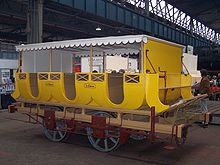Railroad car


A railway carriage , also known as a wagon or wagon (pronunciation: [ vaˈgɔŋ ] or [ vaˈɡɔ̃ː ], southern German / Austrian [ vaˈgoːn ]; plural: Waggons, southern German / Austrian also known as wagons, wagons [ vaˈgoːnə ]), is a rail vehicle without its own drive . A distinction is made between freight wagons , which are used to transport economic goods, and passenger wagons , whose task it is to transport people. In Germany, passenger coaches and freight cars are standard vehicles . The railway company cars are also counted among the railway wagons , which in turn are not necessarily included in the regular vehicles. For many secondary and local railways as well as small railways , passenger cars used to be called sidecars , analogous to trams .
construction
The following assemblies are common to all railway cars:
- Pull and buffers at both ends. This can mean a separate pulling and pushing device, that is, a pair of buffers with a draw hook coupling in between, or a combined pulling and pushing device, i.e. a central buffer coupling . So-called connecting cars have a different pulling and buffing device at one end than at the other, for example for coupling low-floor passenger coaches with couplings in a special design to locomotives with standard-compliant couplings.
- The frame that absorbs the standardized buffer pressure and hook tensile forces and also carries the more or less special devices for receiving and securing the goods to be transported or the passengers. Sometimes the frame and the carrier are inseparable.
- The drive that made each one (mostly) rigid axle front and rear with steel flange - wheels (ie two wheel sets ) or a respective front and rear bogie can be made. Almost all modern railroad cars are four-axle with two two-axle bogies, heavy goods wagons are mostly six-axle with two three-axle bogies each. Increasingly, trains are used that have a weight-saving wagon design with only one Jakobs bogie between two wagons. In Germany, passenger cars with three axles were also widespread until around the 1960s .
- The suspension between the car body / frame and running gear. This connects the two parts elastically with one another and thus largely determines the smoothness and safety of the operation. In addition to leaf springs , modern vehicles also use coil springs , rubber springs and air springs , often in combination with one another.
- The brake system with its standardized parts such as compressed air lines , containers, brake valves, control components and brake pads , but modern passenger cars often have disc brakes . Freight wagons and older types of passenger coaches are usually equipped with block brakes.
The transport of railway wagons on the road is possible with road scooters , which were developed in 1931 by Johann Culemeyer . Carriages of one gauge can be transported on rails of another gauge by means of trolleys or trolleys .
Stock of railroad cars
In Germany in 2003 the following vehicles were in the inventory of Deutsche Bahn AG and other railway companies :
- 107,031 freight cars of the Deutsche Bahn AG
- 57,107 freight wagons from other companies
- 12,269 passenger coaches
literature
- Michael Brandhorst, Torsten Dellmann, Andreas Haigermoser, Markus Hecht, Stefan Karch, Günter Löffler, Wolfgang Rösch: Rail Vehicle Manual. Development, production, maintenance . Ed .: Christian Schindler. 1st edition. DVV Media Group GmbH, Hamburg 2014, ISBN 978-3-7771-0427-0 (576 pages, table of contents online [PDF; accessed on June 8, 2016]).
- Werner Deinert: Railway wagons . Berlin, transpress VEB publishing house for transport. 5th, through. 1985 edition
- Guillery: building the railroad car . Hanover 1908 ( digitized from ULB Darmstadt )
- Günther Klebes: The cars at the railway technology exhibition in Seddin on the occasion of the railway technology conference in Berlin from September 21 to October 5, 1924 . (Railways and Museums Monographs and Communications, Volume 28). Karlsruhe, German Society for Railway History, 1982
Web links
Individual evidence
- ↑ Wolfgang Mück: Germany's first railway with steam power. The royal privately owned Ludwig Railway between Nuremberg and Fürth . ( Dissertation at the University of Würzburg ). Fürth 1985 (2nd revised edition), pp. 115-126


